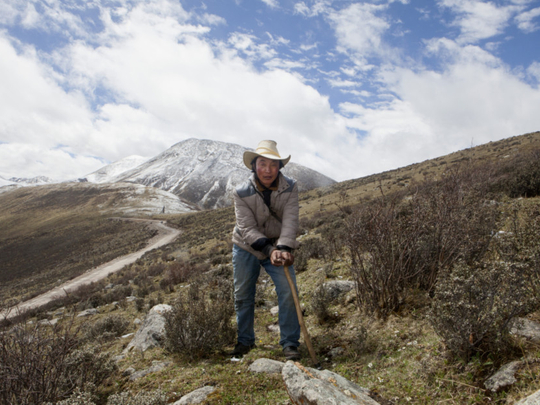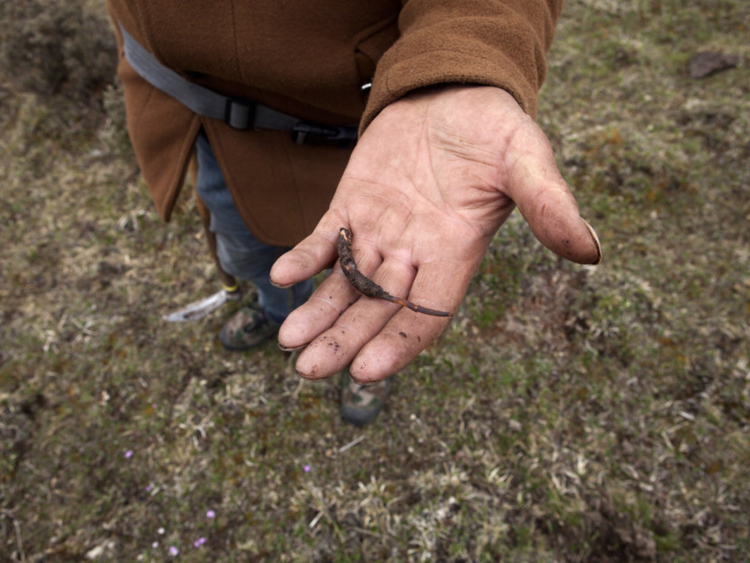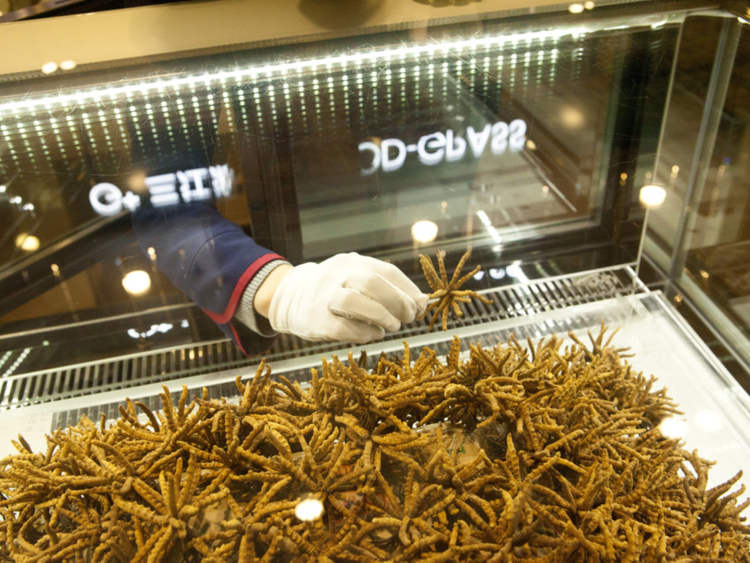
High on the Tibetan plateau, on the sides of steep green valleys dotted with herds of grazing yaks, beneath forbidding snow-clad peaks, a line of adults and children crouch and crawl across the slopes.
They are hunting — not for game but for a tiny brown shoot poking just an inch or two above the ground amid the retreating snows, revealing a mushroom known as the caterpillar fungus. This is “Himalayan Viagra”, and it is so sought after in China for its medicinal and aphrodisiac qualities that it can sometimes fetch its weight in gold.
Tibet’s annual gold rush is in full swing, school’s out and 47-year-old Chu Tsering has brought two of his sons and one daughter on his motorbike to take part in the search.
Chu, his weather-beaten face shielded from the sun by a cowboy hat and shades, owns more than 100 yaks. But he says 90 per cent of his family’s income stems from just two months of work combing the slopes.
“We couldn’t survive without it,” he says.
The same is true for hundreds of thousands of Tibetan herders across a vast swath of the plateau for whom caterpillar fungus is their main source of income, their economic lifeline and their only link to China’s growing prosperity.
Yet that lifeline is beginning to fray. Climate change and overharvesting have made the caterpillar fungus harder to find, say experts and locals, while an economic slowdown and anti-corruption campaign in China have depressed prices. Critics say the Chinese government is not doing enough to ensure the harvest is sustainable or to protect that lifeline.
“Many big Chinese universities have sent researchers, but they just want to know how to cultivate it artificially, to grow it in a lab. They completely ignore what it means for the Tibetan people,” said Daniel Winkler, an ethno-mycologist who runs the website Mushroaming.com. “How to ensure a sustainable harvest is still a big issue, and it’s not addressed. It’s unforgivable how the Chinese government is letting people down.”
The caterpillar fungus is one of nature’s more unusual creations, produced when a fungus penetrates the larva of a ghost moth, growing inside and finally killing its host after it has burrowed beneath the ground. As the snows retreat, a small shoot grows out of the shell of the dead larva, poking its nose above the soil.
It is known in Tibetan as “yartsa gunbu” — “summer grass, winter worm” — and to Western science as Cordyceps sinensis.
The first known reference to its “innumerable” medicinal qualities comes in a 15th-century Tibetan text, which recommends grinding it into a powder and boiling with a sparrow’s chest and yak’s milk. “It sharpens the senses,” the text promises, and “serves best for the purpose of libido, increasing offspring and improving vitality.”
By the 17th and 18th centuries, it was being imported into China for medical use and is mentioned in a Jesuit priest’s account of medical treatment at the emperor’s court in 1736. Even during the chaos of Mao Zedong’s Great Leap Forward and Cultural Revolution, the harvest continued, although Tibetans had to surrender what they found to the Communist Party.
But it was not until the 1990s, as China’s economy opened up and disposable incomes rose, that popular demand for caterpillar fungus exploded — and so did the price. The fungus is now recommended for kidney and lung ailments, to treat cancer and boost the immune system, with annual demand estimated at $11 billion.
Today in a high-end shop in the north-central city of Xining, 700 pieces of Grade 1 Cordyceps weighing 500 grams (1.1 pounds) sell in a velvet-lined wooden box for 264,000 yuan ($40,000), although lower-grade specimens fetch a third of that price. It is marketed as “god grass”, and shop employees don white gloves as they bring sterilised samples out of glass cases. They explain how a unique combination of trace minerals, germ plasm, organic alpine soil and unique climatic conditions give it “supernatural” qualities.
But fascination with Tibetan mysticism is only part of the story. In 2003, as panic spread about an outbreak of severe acute respiratory syndrome (SARS), the fungus was marketed as a cure. Ground into powder, made into tablets, cooked with food or even steeped in alcohol, suddenly the fungus was everywhere, and stocks in the Tibetan capital of Lhasa ran out within days.
China’s gift culture, and the corruption that accompanies it, has also popularised the product. It is far healthier as a gift than alcohol or cigarettes, and more elegant than a bulky wad of cash.
Gyegu in Yushu County is the Tibetan town at the centre of the industry. When harvest time comes around in mid-May, schools are given two months’ vacation and children fan out over the grasslands with parents at their side. With their sharp eyes and shorter legs, they are far better at spotting the elusive root. Then they use a small hoe to carefully lever up a clod of earth and extract the orange “caterpillar”, still covered in mud — and much more valuable when unbroken.
But the hunt is not getting any easier, either because the mushroom is becoming scarcer or because there are simply more people looking.
Chu’s son Niman Dorje, 13, is the best in the family. He says he used to be able to find 80 Cordyceps on a good day, but nowadays 50 is a very good haul. He says it is not fun at all. “I’d rather be at school.”
His dream is to emigrate to the United States one day.
In Yushu’s market, Tibetan women in shawls and floppy hats sit on low stools, gloves on their hands and masks on their faces as they brush the mud from harvested Cordyceps. A monk wanders through with a plastic bag of muddy fungus, while others count huge wads of cash, prayer beads swaying as they thumb red 100 yuan notes, worth about $15. A crowd gathers as a big deal is negotiated, 10 pounds of Cordyceps changing hands for $42,000: The wholesale price is much lower here than in high-end retail shops in the big cities, but this still represents a substantial cash transaction.
The buyer is a man named Abo, 34. Prices have been falling for a couple of years, he says, but he’s hoping that a smaller crop this year will push them back up. “Last year, someone might have been able to find 100 pieces. Now they are only getting 10 or 20 because of the weather,” he said.
In February, a new threat emerged when China’s Food and Drug Administration found that powders and tablets made from the fungus contained more than four times the safe limit for arsenic. But in Yushu, dealers insist their product is safe.
“It’s because there are a lot of fakes out there,” said one dealer. “Consumers buy it and they find it isn’t working, so that affects business.”
But does the fungus actually work? While no Western studies have proved its efficacy, ethno-mycologist Winkler points to East Asian studies and research at Britain’s University of Nottingham into the potential use of cordycepin, a chemical extracted from the Cordyceps, as a painkiller in the treatment of osteoarthritis and possibly cancer.
Tibetans say the product is too expensive for them to consume, but the income it brings has transformed communities. People across the plateau have bought motorbikes and cars, solar panels, freezers and televisions. They also have financed their children’s education, stashed savings in the bank and even clubbed together to repair local roads. The fungus has brought economic empowerment and employment, including for women, says Emilia Roza Sulek, a socio-anthropologist who studied the impact of the fungus in southeastern Qinghai.
But it also has brought tales of drunkenness and gambling, of environmental degradation and even violence. Hundreds of thousands of people trample the grasslands for the fungus, leaving trash in their wake, while neighbouring communities, armed with knives or rocks, often have clashed for access to the best harvest grounds, sometimes fatally. In 2013, Tibet’s exiled spiritual leader, the Dalai Lama, appealed for calm, calling the quarrels a crisis.
Near remote Xiaosumang, Sanding Dorje patrols the slopes, ever on the alert for an out-of-town licence plate on an approaching motorbike. “Some outsiders came last year and picked the fungus on a holy mountain,” he said. “But then a thunderstorm came, and they were forced to kneel and prostrate themselves, to atone for their sins.”
–Washington Post














